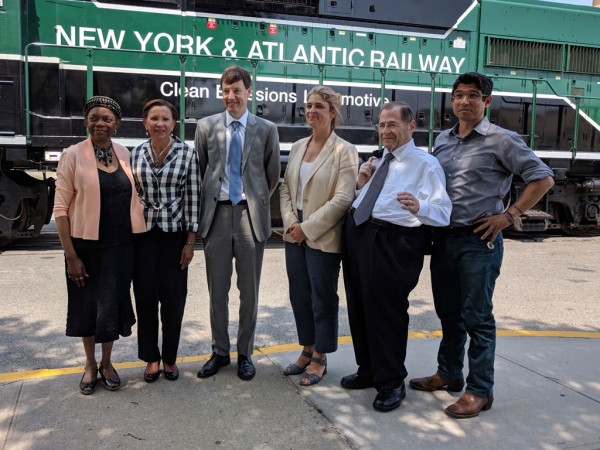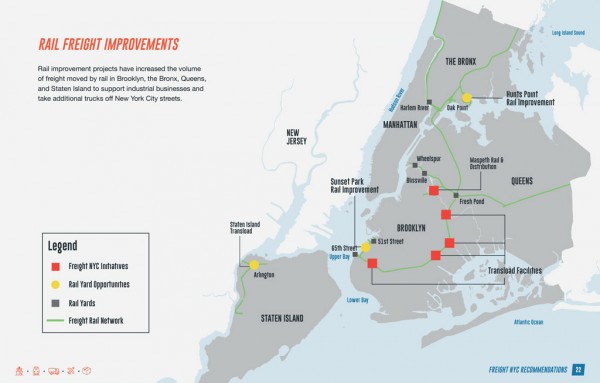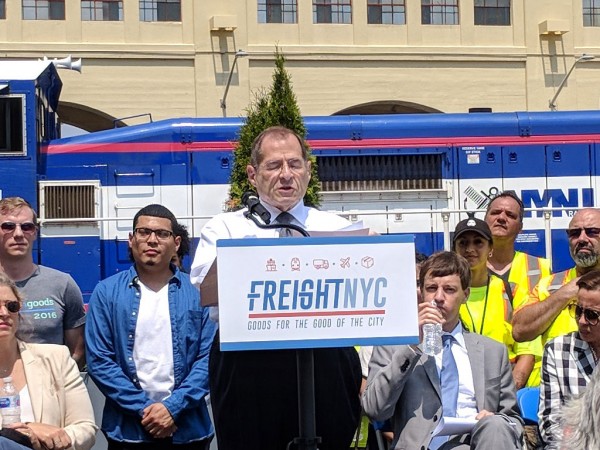NEW YORK – The de Blasio Administration, federal, state and local elected officials, and industry experts unveiled Freight NYC, a $100 million plan to overhaul the city’s aging freight distribution systems through strategic investments to modernize our maritime and rail assets and create new distribution facilities, with the ultimate goals of creating nearly 5,000 good-paying jobs for New Yorkers and a more sustainable and resilient supply chain network.
“Freight NYC is an investment in our city’s future,” said Mayor de Blasio. “By modernizing our approach to shipping, we will create thousands of good-paying while keeping our streets safer and cleaner.”

New York City depends on crucial but aging marine, rail and highway infrastructure and relies upon trucks to move nearly 90% of freight. As the City’s population continues to grow and consumers increasingly demand near-instant deliveries, local freight volumes will grow an estimated 68% by 2045, further choking traffic and impeding commerce. This challenge is particularly acute in the “last mile” of distribution, in which trucks bring goods from port facilities and central warehouses, often located in neighboring states like New Jersey, to consumers over city streets and arteries.
The Freight NYC plan leverages three key strategies to modernize and strengthen the City’s freight distribution industry for the 21st-century:
Investing in Multimodal Infrastructure
Working with the Port Authority of NY & NJ, the City will invest in marine terminals and barging operations, and support the modernization and expansion of rail lines and freight facilities, creating approximately 900 jobs. Highlights of these efforts include:
- Developing a barge terminal to serve the Hunts Point Food Distribution Center in the Bronx, allowing produce and other food products to reach Hunts Point by water, rather than by truck.
- Constructing a barge terminal at the South Brooklyn Marine Terminal in Sunset Park to connect Brooklyn’s consumer base to the new barge network.
- Reactivating underutilized rail lines by constructing new transload facilities within the existing rights-of-way and new passing lanes to alleviate track congestion

Creating New Freight Distribution Hubs
Through public-private partnerships, the City will develop new distribution, warehousing and transload facilities to meet increasing demand. This will help ensure the City can sustain the demands of its growing population, while creating secondary pathways to move goods in the event of adverse climate impact and other major disruptions. Highlights of these efforts include:
- On July 20th, NYCEDC will release a request for proposal (RFP) for a private partner to build an Urban Distribution Center at the Brooklyn Army Terminal that is at least 500,000 square feet, estimated to create 500 jobs in Sunset Park.
- NYCEDC will release an RFP next week for a 4-acre site near JFK Airport to develop an air cargo and distribution facility that will help meet the needs of current businesses while ensuring the efficient flow of airport goods and maintaining JFK’s position as a leading international freight destination
Promoting the Use of Clean Trucks, Reinforcing 2015 Clean Fleet Goals
The City, led by the New York City Department of Transportation, will encourage the deployment of cutting-edge and emission-free trucks on city streets for last mile delivery, which will help advance the Mayor’s goal of reducing 80% of gas emissions by 2050. Highlights of these efforts include:
- Supporting the expansion of the NYCDOTs Hunts Point Clean Trucks Program to other truck hubs and Industrial Business Zones. The program offers a rebate to applicants that replace, retrofit, or retire older, heavy-polluting diesel trucks
- Supporting the development of clean fuel infrastructure in freight hubs, including sites for compressed natural gas and electric charging, while promoting truck safety measures to help meet NYCDOT’s Vision Zero goals.
- Piloting initiatives for tenants in City-owned properties to green their own supply chains through logistics consolidation, carbon-neutral shipping, and use of clean vehicles
Freight NYC compliments NYCDOT’s Smart Truck Management Plan, which DOT will release later this year to guide shorter-term freight planning and management, focusing more directly on improving the effectiveness of the 90 percent of goods that move by truck in New York City.

“The New York region needs a better way to move goods, plain and simple. On this, there is overwhelming consensus. We must end our over-reliance on trucks that clog and destroy our roads, make the cost of doing business and consumer goods more expensive, harms our environment, raises childhood asthma rates, and creates safety and national security vulnerabilities,” said Congressman Jerrold Nadler. “Today’s announcement of Freight NYC by Deputy Mayor Glen, which will involve making key investments in maritime and rail infrastructure is the first step in finally addressing this very serious problem, and I applaud Mayor de Blasio for his dedication to this freight plan and for his support of the Cross Harbor Rail Freight Tunnel project, which is the long-term freight solution for our region, and which is currently undergoing a Tier II EIS analysis by the Port Authority.”







